Select Measure Item
 in the Review Creation
toolbar.
in the Review Creation
toolbar.
Several things now happen:
-
The arrow pointer
 changes
to the measure pointer
changes
to the measure pointer
 . Depending on the position of the measure pointer, it will
also show a symbol indicating the object you can select
with it. For a list of all the measure pointers, see
Pointer Transformation.
. Depending on the position of the measure pointer, it will
also show a symbol indicating the object you can select
with it. For a list of all the measure pointers, see
Pointer Transformation.
-
The Measure Item dialog box appears
with the Specifications tab activated and Customize tab grayed out:
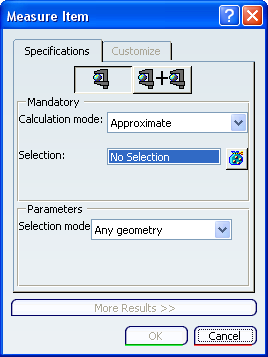
Move the measure pointer
 over the geometry.
over the geometry.
As you do this, the symbol to the bottom right of the
pointer changes to reflect the geometry type and to help you with your
selection. Also, dynamic highlighting of geometric
entities helps you locate the item to be selected.

You may care to narrow the detection criteria to be
used.
Click when the pointer is above the object whose geometric
properties you want to measure.
Several things now happen:
-
The selected object is highlighted in the geometry
and in the specification tree.
-
An information box appears, providing information about the properties of the selected geometry. Drag this box to
move it. A full list of detectable objects
is provided in Pointer Transformation. Here are some examples:
A plane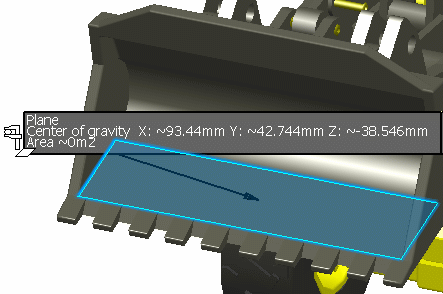
A surface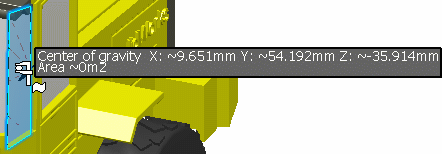
A volume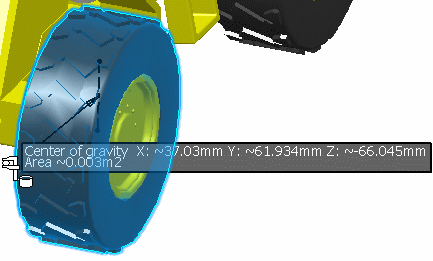
-
The Customize tab and More Results >>
section in the Measure Item dialog box are now activated
and both the geometry type and name of the object you selected are
indicated in the Selection field.
-
A Measure item is created in the specification tree
under the Notes branch with the name Measurexxxx.y where
xxxx is the selected geometry type and y the number of measures
made under the same slide and for the same type of geometry:

Using the same method as just described, select several
geometric entities:

After the second selection, the contents of the
Selection field change to show only the number of selected entities.
To see a detailed list of your selections, click the
 button to the right of the Selection field.
button to the right of the Selection field.
The Measure Selections dialog box appears:
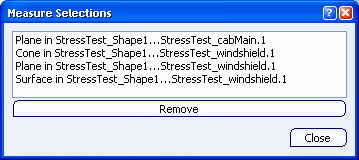
To remove any selections in the list, select the unwanted
line(s) and click Remove. You can also do this by reclicking
the selected entity in the geometry.
Note that you cannot remove all selections.
At each selection (or selection removal), the related
information changes interactively in the More Results>> section:

This information also appears in the information box:

The corresponding measures are added under the Notes item in the specification tree:

Click OK.
To edit an existing measure, you have three options:
-
Double-click the measure in the specification tree.
-
Double-click the information box in the geometry
-
Right-click the measure in the specification tree
and, in the contextual menu that appears, select [measure_name]
object>Definition... .
Once created in the specification tree, the selections
of non-associative measures cannot be modified. If you click the
 button, a warning message appears:
If you click Yes, all the selections will be removed from
the list in the Measure Selections dialog box. You can now
make new selections.
If you click No, the selection list remains unchanged.
Note that you can reopen any Measure to access the Customize
tab and the Results section.
button, a warning message appears:
If you click Yes, all the selections will be removed from
the list in the Measure Selections dialog box. You can now
make new selections.
If you click No, the selection list remains unchanged.
Note that you can reopen any Measure to access the Customize
tab and the Results section.